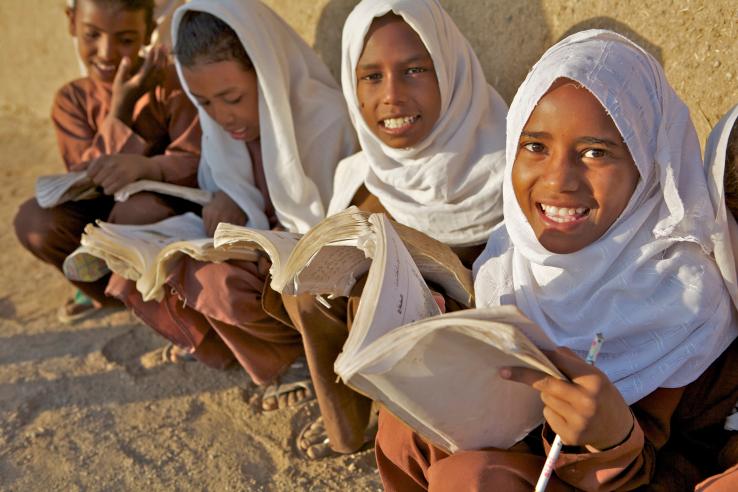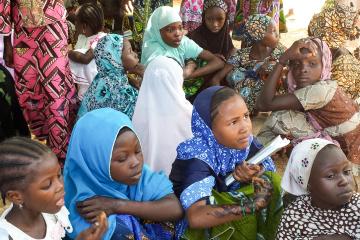Building girls’ agency at scale: Lessons from life skills programs in Africa

Last year, J-PAL published a policy brief and implementation guide synthesizing evidence from sixteen randomized evaluations of life skills programs for adolescent girls. The findings show that such approaches can be particularly effective in boosting self-efficacy (confidence in achieving certain tasks) and aspirations, and shifting internalized gender norms. They can also improve downstream outcomes in education and employment. In some cases, programs have been associated with reductions in gender-based violence, early marriage, and pregnancy.
Building on these insights, in May 2025, J-PAL Africa convened implementers, policymakers, funders, and programme alumni through a webinar to reflect on a central question: how can effective pilots grow into sustainable, scalable models? Their discussion highlighted both the opportunities and trade-offs involved in scaling a life skills program. Building on the conversation, we reflect on three overarching takeaways: the role of rigorous evidence, the importance of government and community partnerships, and the remaining gaps in the evidence base.
First, some background
Worldwide, women account for over sixty percent of adults without basic literacy skills, and fewer than half of working-age women participate in the labor force. Compared to men and boys, women and girls tend to marry younger and complete fewer years of formal education. While external constraints, such as financial limitations and entrenched social norms, can explain some of these outcomes, internal barriers, including limited self-confidence and self-efficacy, also play a role.
In response, life skills programs have emerged as one approach to strengthening girls’ psychosocial and soft skills like communication, negotiation, and self-efficacy that support them in making important life choices.
Evidence as a compass
In a world of complex challenges and limited funding, rigorous evidence offers a compass for decision-making. It can help practitioners and policymakers understand what works, for whom, and at what cost. By embedding evaluation into program design, implementers can make informed choices about which components of life skills to scale and how to adapt them effectively.
During the webinar, Naira Kalra of the Population Council outlined how Kenya’s Adolescent Girls Initiative (AGI-K) put this approach into practice. Through the simultaneous testing of differing sets of programme components, researchers and implementers were able to identify which combinations produced the best education, health, financial, and social outcomes. Evidence from the pilot not only motivated local counties to pursue scale-up but also informed which elements to prioritize.
Meanwhile, in Zambia, pilot results from the Adolescent Girls Empowerment Program showed no improvements in education or reductions in teenage pregnancy. As Naira noted, rather than moving ahead with scale-up, the implementing team used those early findings to refine the program design and sharpen its focus.
In both Kenya and Zambia, data and evidence played a critical role in helping teams decide where to invest and how to strengthen their approach.
Yet, as Naira cautioned, using evidence to inform decisions is rarely simple. While data can highlight the most effective and cost-effective approaches, Emma Sarton of the Girls’ Education Challenge reminded us that it is not just a technical process. It is also one that is highly political and relational, that has practical and political considerations.
In Kenya, for instance, individual cash transfers, a component of these life skills programs, were found to be more impactful than community-level ones. But in some counties, local governments opted for the latter because they were easier to deliver and better aligned with community preferences. Evidence can shape the conversation, but turning research into action often means working within real-world constraints.
Aligning with national priorities is critical, but so is ensuring fidelity to the evidence
Scaling succeeds when key decision-makers’ commitment to a program's growth and sustainability is nurtured through early, continuous, and collaborative engagement. A good example of this is Zambia’s Girls Arise! program. Designed to equip girls with negotiation skills, the intervention was highly successful in increasing girls’ school enrollment and attainment, academic performance, and negotiation skills.
Seeing the program’s success in addressing school dropout and teenage pregnancy, strong advocates like Remy Mukonka, formerly with Zambia’s Ministry of Education, championed early engagement of government ministries during the research phase. This facilitated the integration of elements of the curriculum into national education reforms, broadening the program’s impact and reach beyond the original NGO pilot.
Zambia’s case demonstrated how aligning with national priorities and leveraging public systems early on can support long-term integration. Without such alignment, even highly effective programs can remain stuck at the pilot stage. However, governments operate within their own set of constraints and agendas. In Zambia, this meant that only certain program components could be adopted at scale, raising questions about how to sustain impact at a broader level.
Getting community buy-in remains front and center to scaling
Engaging parents, husbands, and religious leaders helps to build trust and shift social norms, making it more likely that girls can participate and complete life skills training, arguably the most critical component of a life skills program.
As highlighted in J-PAL Africa’s Design Guide for Life Skills Programmes, co-authored with Emma Sarton, actively involving communities can transform how girls’ spaces are perceived. The Girls Education Challenge found that enlisting trusted and respected local gatekeepers helped clubs be seen as valued learning opportunities instead of “gossip spaces” or cultural threats. Similarly, inviting mothers to join activities strengthened mother–daughter bonds and reinforced the legitimacy of the clubs, often leading to greater parental involvement in girls’ education overall and attendance in these clubs.
Frontline implementers such as teachers and safe space mentors also play a pivotal role. In the webinar, Habiba Mohammed of the Centre for Girls’ Education emphasized how training them to deliver life skills doesn’t just build capacity, but also transforms pedagogy itself by fostering more learner-centered and gender-sensitive classrooms. But with teachers already stretched, sustaining quality at scale requires ensuring they can remain motivated and supported.
Advancing new research to help programs reach more girls… and boys
A growing body of evidence shows that life skills programs can improve girls’ agency and educational outcomes. However, gaps remain, particularly around how these programs impact labor force participation, early marriage, pregnancy, and gender-based violence outcomes.
As the panelists discussed, this also means that the piloting and scaling of these programs should not follow the same template everywhere. To better understand what works, when, and for whom, we must understand that diverse groups of girls, such as married girls, young mothers, out-of-school adolescents, and older youth, face distinct challenges that require tailored approaches. Building flexibility into program design is critical to ensure no group is left behind.
We must also ensure that programs include boys and men. Speakers noted that while programs like AGILE in Nigeria and SWEDD across the Sahel region are beginning to pilot male-focused components such as “husbands clubs”, the evidence remains exploratory. Expanding this work will be essential to create environments where girls’ empowerment can be sustained, while increasing the impact and reach of life skills programs.
Looking ahead
Sakina Abdulkadir, one of the final speakers closing the webinar and a recent life skills program alumna, shared how life skills training made the difference between dropping out of secondary school and becoming the first girl in her community to enroll in tertiary education. Today, she supports her siblings’ schooling and serves as a visible role model, shifting community perceptions of what girls can achieve.
Her story illustrates the ripple effects that life skills programs can generate, from personal transformation to broader social change, and highlights the challenge ahead: How to make stories like Sakina’s more commonplace.
Evidence must remain the compass guiding what to scale and how, but lasting success also depends on the systems and partnerships that can carry programs forward. If governments embed life skills into national curricula, if teachers and mentors are motivated and supported, and if communities see value in girls’ empowerment, then life skills programs can move beyond small pilots to become sustainable, scalable, evidence-based models.
This is how the next generation of girls across Africa, like Sakina, will have the confidence, skills, and opportunities to invest in themselves and shape their own futures.
Want more evidence-based insights on life skills, education, and girls’ empowerment? Subscribe to our newsletter.



